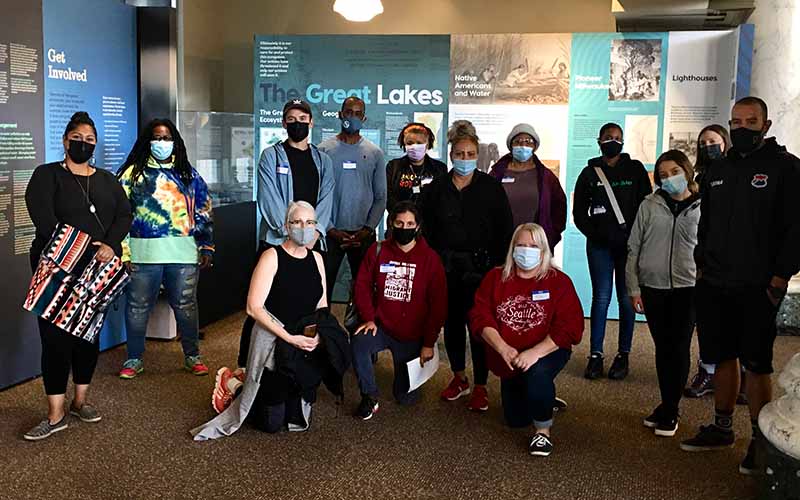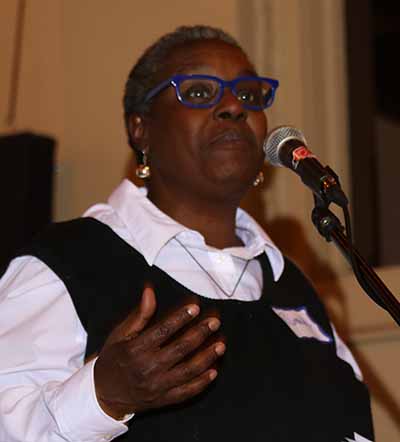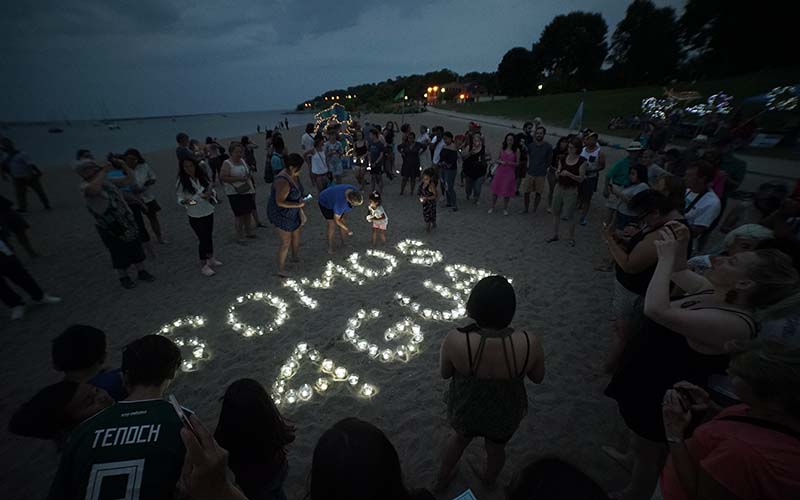Read this in Spanish / lee esto en español
Brenda Coley is the co-executive director of the Milwaukee Water Commons.
Who are you/what is your role?
I am the co-executive director of Milwaukee Water Commons. We are a cross neighborhood multi-cultural organization built to engage and empower all communities in solution-making and stewardship of our waters.
What kinds of things are you seeing in that community that could be related to climate change?
I think when you talk about the Great Lakes region and speak about climate change, where you really see it is in more frequent rain events, which often results in flooding, especially in urban areas where there are these issues with storm water. We have old infrastructure and you see repeated amounts of flooding, it can be challenging to deal with the repeated rain events. People dry out their basements, but then comes another storm, and yet another, and that can tear down community resilience.

What does your group do to help people build more resilience?
At Milwaukee Water Commons we strive to work in solidarity with the community. We are working to assist you. We are attempting to work together with the community on the main issues that you’re challenged with around the environment and climate, as well as engage the community around being stewards of our gift of water. When you work with environmental justice you begin to have an understanding of the intersectionality of issues that connect with climate resilience. It may not just be flooding; it may be other things that are connected to that.
One of the things we feel mediates flooding is green infrastructure, but, when you talk about bringing green infrastructure to a community, we talk about why green infrastructure is important. We also, and this is where the intersectionality comes in, we also try and communicate in transparent and authentic ways, alert folks, tell them our work is not being done to gentrify the neighborhood. Many times, when green infrastructure comes into the neighborhood, the community becomes regentrified. That’s why we talk about being in solidarity. We are really working with the community to bring about changes the neighborhood feels are necessary.

I’ve heard this before, adding more trees can lead to gentrification, is that an argument against that?
It’s not a reason, or an argument not to do the work. It more presents the need for our assistance and our agenda to be as authentic and transparent as possible. The people in vulnerable neighborhoods and communities deserve to have the benefit of trees in their communities as all people do. There is a huge effort among several environmental groups including our waste water institutions and the City of Milwaukee Environmental Collaboration Office to work together and plant trees. We are all aware that included in this issue are jobs that will benefit the community, for planting and maintenance.
So, to take stock of the history and current challenges facing Milwaukee’s tree canopy, highlight the potential for environmental, economic, and social benefits of rebuilding the canopy, and mobilize stakeholders around a comprehensive plan to realize these benefits, Milwaukee Water Commons coordinated a stakeholder engagement process — Branch Out Milwaukee — that has developed the Branch Out Milwaukee Master Plan.
As discussed in this plan, increasing urban canopy would reduce heat vulnerability and related health risks and energy costs. It would also improve air quality, public health, and economic stability in urban neighborhoods and deliver well-paying green jobs for Milwaukee residents.
Separately, Milwaukee Water Commons co-coordinated the Milwaukee Water Equity Task Force, in collaboration with the Madison Metropolitan Sewerage District, Water Works, the United States Water Alliance, and other stakeholders, that produced the Milwaukee Water Equity Roadmap, a plan for aligning increased regional investments in green infrastructure with a commitment to workforce equity, including access to living wage jobs and community benefits for marginalized communities.
The Branch Out Master plan and the Water Equity Roadmap were developed following multiyear stakeholder engagement efforts to reflect broadly shared community concerns and goals. As the facilitator of the Branch Out Milwaukee partnership and the Milwaukee Water Equity Task Force, Milwaukee Water Commons is positioned to bring our communities together with stakeholders and decision-makers to create structural change in green infrastructure.

You get the conversation going upfront before the green infrastructure comes in so people understand why it’s happening?
Milwaukee Water Common’s model for community engagement and empowerment puts communities at the center of developing solutions to the problems that affect them. Community engagement is not just a box to check off; it is a central underlying principle for successful policy development and implementation. Milwaukee Water Common’s work with the Branch Out Milwaukee coalition is building support for equitable replacement of Milwaukee’s tree canopy.
Community engagement is the foundational step of the project and is the basis from which community priorities are determined, project parameters are set, and plans are developed. Yet funders of this work are primarily concerned with getting trees in the ground. We believe this is short-sighted because long-term environmental benefits of trees are only achieved when trees are maintained, which is dependent on community support for the siting of trees in the first place. Our challenge is to continue to impress upon our organizational and funding partners the importance of community engagement to the long-term success of environmental project.
What would you want people to know about the communities that you serve?
All people have a right to clean drinking water and Milwaukee Water Commons engages all sectors of our community on these issues, not only marginalized communities. We all face important decisions regarding our waters. We all rely on them for fishing recreation, transportation, commerce, and to have world class drinking water. We all deserve clean drinking water. We have agricultural runoff in rural parts of the state and polluted ground water from Per- and Polyfluoroalkyl Substances (PFAS). And now we have another water related issue with the detrimental effects of climate change.
At Milwaukee Water Commons, we believe in that by inviting leadership, and the innovation that comes from throughout the community, only then can we truly get a good grasp on climate resilience.
Is your organization’s focus mainly on green infrastructure or do you have a broader focus?
In 2015 Milwaukee Water Commons embarked on a process to ensure that the community was at the center of envisioning and decision making about our city’s water future. Although at the time Milwaukee water was on the civic agenda, the vast majority of Milwaukee community members were not included in the conversation. After two years of engagement within many dimensions of the community we formulated the Water City Agenda. What would it take for Milwaukee to be a truly water-centric city? And in those conversations, we probably had about 1,200 people participate.
The Water City Agenda has six initiatives with 10-year goals: arts and culture, education and recreation, blue/green gobs, green infrastructure, drinking water, and water quality. We are instituting programming under all these initiatives.
How does your group make these connections?
We try to share about the benefits of water. It’s our shared friend. We work to make sure that all communities have the opportunity to share equally in the distribution of the benefits of water. That means informed decision making regarding the challenges. Without the input of the whole community our decisions will be flawed. We engage the community around putting the health of the community in the center of our decisions and that the benefits and the responsibility and the care of the water must be shared by all.
Do you have hope for the future?
I have tremendous hope for our future because I know that, even though we have a lot of angst at the moment, we are generally going in the right trajectory. There are shifts going on. We live in a multicultural, multiracial society and we must share decision making. At Milwaukee Water Commons, our responsibility is to organize collaborate and innovate.
We are beginning to understand that we must have the input of the whole society, especially at the community level because that is where the innovation will be around climate and climate resiliency. They have the lived experience we can all draw upon. We must clear the roadway so people can find ways to give input. That’s our responsibility as an organization.
Learn More
- Milwaukee Water Commons
- Master Plan: Branch Out Milwaukee Campaign
- City of Milwaukee | Environmental Collaboration Office
- Milwaukee Metropolitan Sewerage District | Water Equity Task Force
- US Water Alliance | Milwaukee: An Equitable Water Future
The views and opinions expressed in this interview are those of the authors and do not represent official policy or position of the University of Wisconsin-Madison or the Wisconsin Initiative on Climate Change Impacts.
For More Information
Brenda Coley, Co-Executive Director
Milwaukee Water Commons
Adams Garden Park
1836 West Fond Du Lac Ave.
Milwaukee, WI 53205
(414) 763-6199